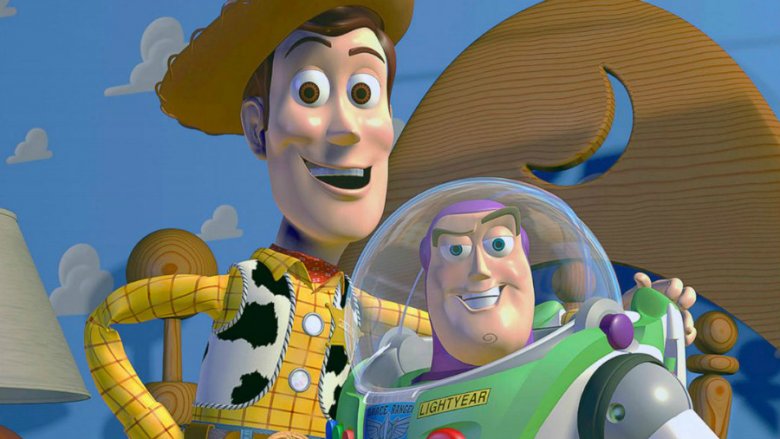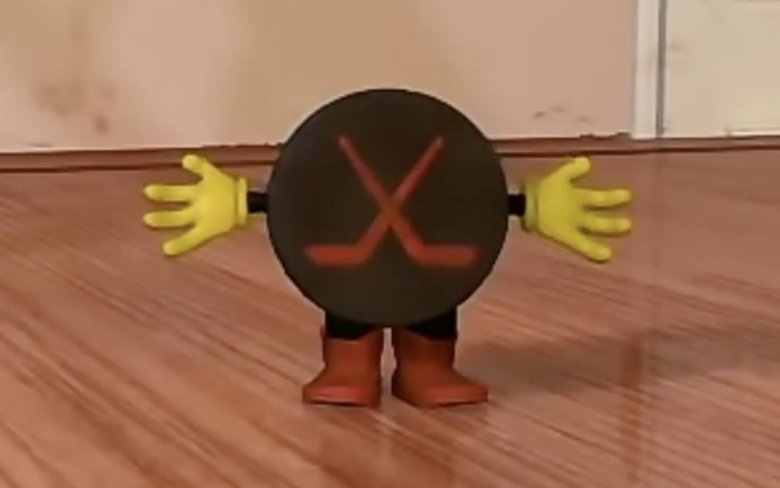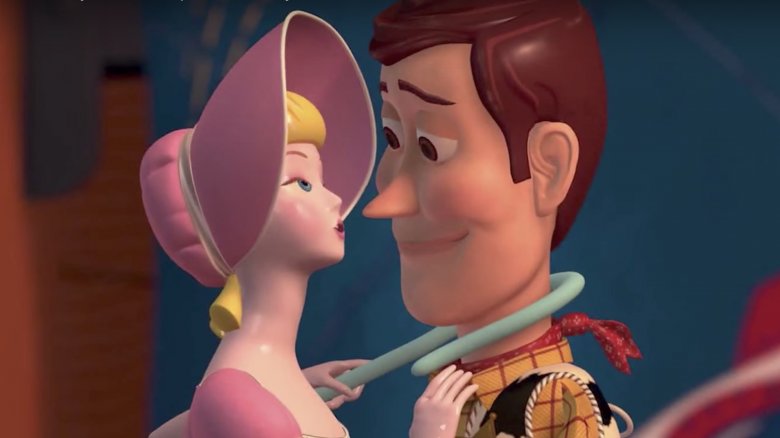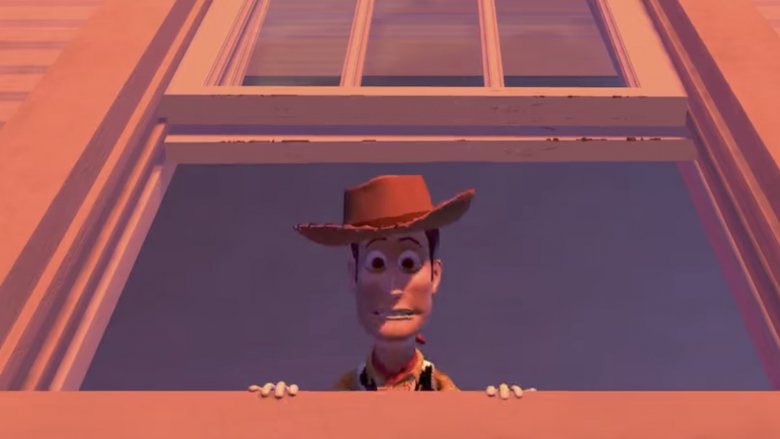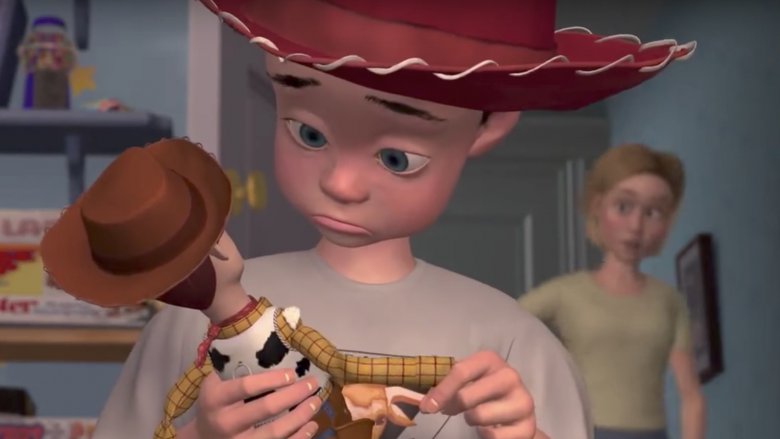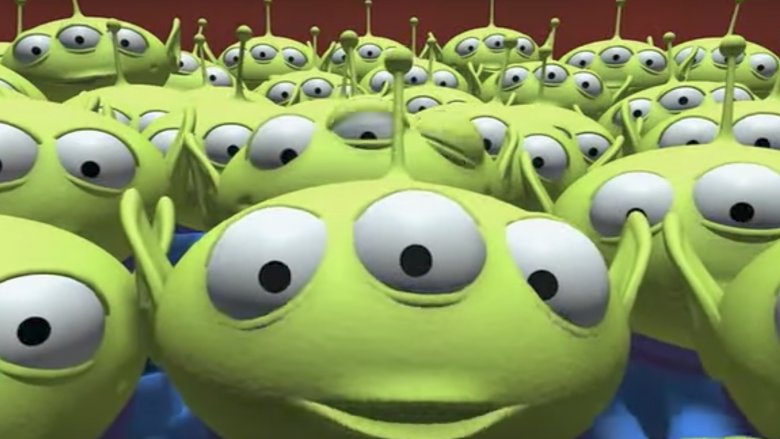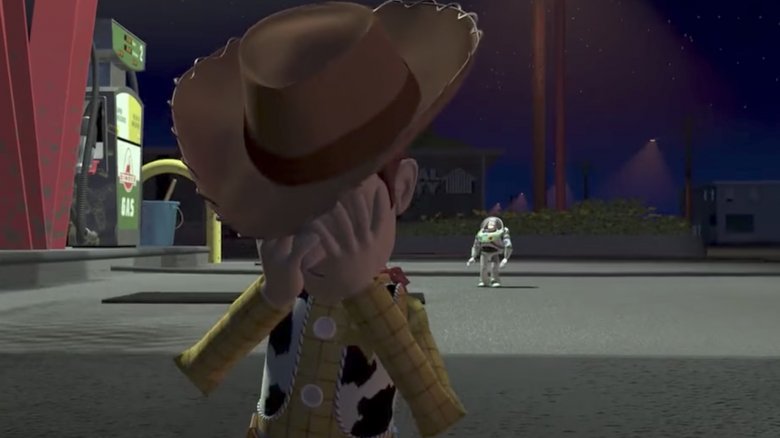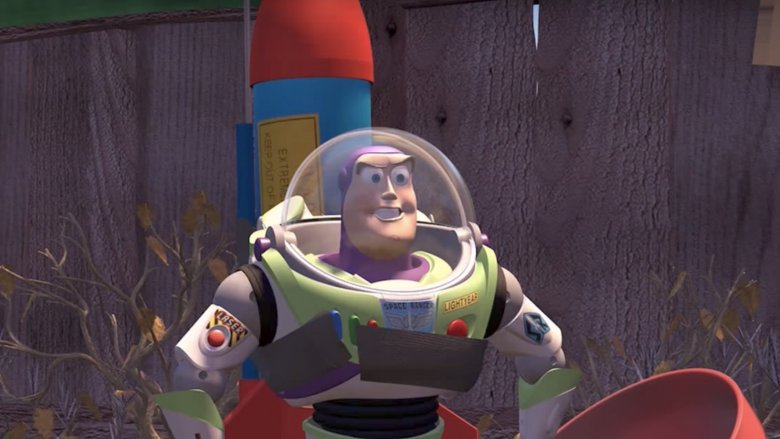Things About Toy Story You Only Notice As An Adult
In 1995, Pixar made a huge splash with its first full-length film, Toy Story, which was also the first ever completely CGI-animated feature length film. With the voices of big stars like Tom Hanks and Tim Allen helping bring the tale about the secret lives of toys to the screen, Toy Story became the number-one box office draw of the year in the U.S. Two more sequels followed, all earning critical praise and commercial success, but the original Toy Story remains something to behold. It's so well made and well written that it begs repeat viewings... especially as an adult. Older viewers notice stuff in the movie that they didn't pay any mind to as kids. The result: Toy Story emerges as a dense, sometimes dark movie with more layers than one could have ever imagined as a little kid.
Kids wouldn't get the subtle pop culture references
Animators filled Toy Story with subtle gags, Easter eggs, and cultural references that very few children would understand... but which their parents and guardians would. For example, the character of Mr. Potato Head is voiced by the late, great insult comedian Don Rickles. After conversing with Hamm, Mr. Potato Head cracks, "What are you looking at, ya hockey puck?" And then he walks past a hockey puck—because sporting goods count as toys in Toy Story—who shrugs at the comment. "Hockey puck" was probably Rickles' most famous barb.
In the scene in which Woody is trapped at Sid's house under a plastic crate, it's held in place by a toolbox bearing the name "Binford Tools." That's not a real company, but the fictional tool supplier that was the sponsor of Tool Time, the home improvement show-within-a-show on Home Improvement, the '90s sitcom that starred Tim Allen, the voice of Buzz Lightyear.
One other creepy thing about Sid's house is the carpet. How can a carpet be creepy? Because it's the same pattern as the carpet of the nightmarish Overlook Hotel in the 1980 horror classic The Shining.
There are some adult-oriented jokes
Something very intimate is definitely going on between Woody and Bo Peep. They have a conversation that a little kid would take pretty much at face value, but adults in the know recognize as highly suggestive. Bo Peep suggests she and Woody get together later on, and that she'll "get someone else to watch the sheep tonight." Tonight—as in all night. Bo Peep is pre-arranging a booty call. (They later share a smooch under some mistletoe, which is held aloft by Bo's sheep.)
Another risqué joke requires a bit more unpacking. One of Sid's freaky frankentoys is named Legs, and she consists of what appears to be the long, shapely legs of a Barbie doll connected and a hook on a line. In other words, Legs is a "hooker."
The good guy is kind of the bad guy
Woody is a kind cowboy in the vein of classic good-guy cowpokes like Roy Rogers and Gene Autry. One thing that sets him apart is that although he's the hero of the movie, Woody moves proactively and explicitly to permanently dispatch his rival.
Woody moves to get rid of perceived interloper Buzz Lightyear, intending to knock him behind a piece of furniture so he'll get lost. He instead knocks him out of an open window, where there is little chance he'll ever be found. (Even worse: he grabs the remote of R.C., the remote-controlled car, and forces that toy to be the one to nudge Buzz, thereby making R.C. an unwilling accomplice.) Usually in Disney movies, it's the bad guy who tries to kill the good guy; in Toy Story, the good guy tries to kill the other good guy.
What happened to Andy's father?
Divorce is a part of life for millions of kids, and a savvy young viewer, perhaps one who has lived with split-up parents, might just assume that Andy's parents in Toy Story are divorced. But that's not necessarily what's actually going on in the movie. An adult point-of-view reveals a complete non-existence of Andy's father, at least in Andy's house.
Throughout three Toy Story films, which include major events such as birthday parties and leaving home for college, Dad never makes an appearance. His absence, be it due to death, divorce, or simply away on business, is never explained. The father is never even mentioned, nor does a picture or letter from him hang on the walls of Andy's room.
There's something weird going on with the aliens
Adults have been alive longer than kids, obviously, and so they've seen a bit more of the world, and become a bit more wise to and wary of its ways. This point-of-view affects how adults watch movies, which is in a more critical or analytical way than do most kids. Young viewers, for example, may think little of the sea of little green aliens in the coin-operated prize-grabber machine at Pizza Planet, all clamoring to be "chosen" by the great, powerful, and mysterious Claw, which decides who stays, and who goes.
Adults, however, are able to perceive this sequence on another level. Those aliens are essentially brainwashed cult members and they blindly and totally worship the Claw, a inanimate object, as their god. Pretty dark stuff for a kids movie.
It's a movie about anxiety and identity issues
Toy Story is a movie for kids, but some of its themes are very adult and very dark. At its core, it's a movie about both mental illness and male anxiety. For the first half of the movie or so, Buzz Lightyear believes that he really is an actual space ranger, and therefore not a toy.
He is so firmly under that delusion that he cannot see his reality for what it is—he hangs around self-aware toys and lives in a child's room (and freezes when real humans come around) but still does not waver in his stance. The only thing that makes Buzz realize he is a toy is when he sees a TV commercial for Buzz Lightyear toys, and in it sees rows and rows of himself on a toy store shelf. Buzz immediately, and understandably, becomes quite depressed.
Also dealing with an identity crisis is Woody, the film's other main character. His main motivation for getting rid of Buzz is to remain the dominant toy in Andy's heart and toy box. An old-fashioned toy, he is extremely threatened by the shiny, high-tech Buzz Lightyear toy swooping in and stealing his place as Andy's favorite. He's like a cowboy doll version of Willy Loman from Death of a Salesman, desperately trying to hold on to relevance and usefulness in a changing world that finds him increasingly obsolete.
The toys can't die, or if they can, it's in a horrific way
The toys of Toy Story are living things, of course, because they clearly walk, talk, think, and feel. But that isn't the same as being a biological organism. The main difference between the toys and animals, for example, is that they cannot die in a normal fashion.
They are simply played with or not played with. If they are played with, great. If not, they sit on a shelf, or in a toy box or some other storage option indefinitely, aware of the passage of time as they remain perfectly still, silent, and with their eyes open while they wait and wait and wait to be played with, a moment which may never come. However, toys can apparently die, as Sid blows up a Combat Carl action figure; Buzz nearly meets his end in a similar way, as Sid ties a small rocket to his back. So toys can die, but the only means by which to kill them is with brutal, painful torture.
Certain names jump out of the credits
This doesn't concern the plot and world of Toy Story as much as it does its creative team. Generally speaking, little kids probably don't pay much attention to a movie's credits—the younger ones can't read, or at least not very well, and they're far more wrapped up in the world of movie than adults.
That means when a viewer does get old enough to pay attention to the names that flash up at the beginning and end of a movie, they're likely to discover "secrets" about the movie's production that have been hiding in plain sight all along. The main example here: one of the credited screenwriters of Toy Story is Joss Whedon. Toy Story came out in 1995, which means Whedon worked on it after the release of the poorly-received Buffy the Vampire Slayer film, but before he debuted his beloved Buffy the Vampire Slayer TV series, not to mention Angel, Firefly, and Dollhouse, and well over a decade before he started writing and directing smart superhero blockbusters in the Marvel Cinematic Universe.
